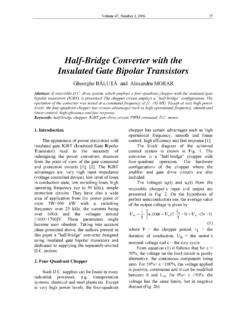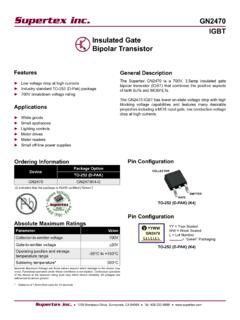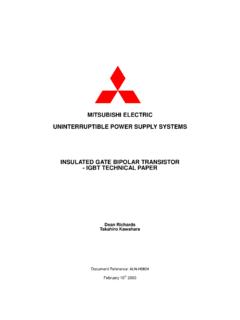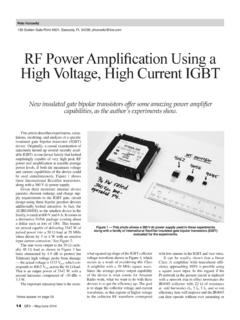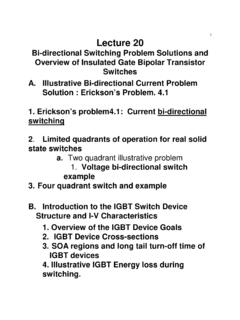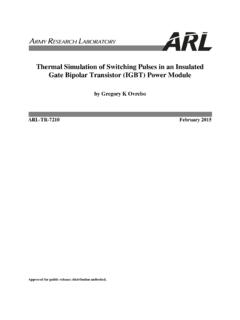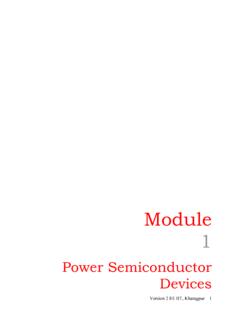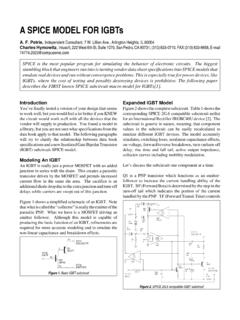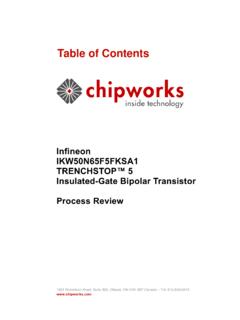Transcription of Insulated Gate Bipolar Transistors (IGBTs) - ece.uic.edu
1 Insulated gate Bipolar Transistors (IGBTs)Zheng Yang(ERF 3017, email: Power Semiconductor Devices and Integrated Circuits Silicon Power Device Status OverviewSilicon Power RectifiersIn the case of low voltage (<100V),the silicon P-i-N rectifier has been replaced by the silicon Schottky rectifier. In the case of high voltage (>100V),the silicon P-i-N rectifiercontinues to dominate but significant improvements are expected. Silicon Power SwitchesIn the case of low voltage (<100V)systems,the silicon Bipolar power transistor has been replaced by the silicon power MOSFET. In the case of high voltage (>100V)systems,the silicon Bipolar power transistor has been replaced by the silicon IGBT. Power devices from wide-bandgap materials [cited from H Amano et al, The 2018 GaN power electronics roadmap , Journal of Physics D: Applied Physics 51, 163001 (2018)]BackgroundCons of power BJT:(1) One of the major shortcomings of the power BJT is its low-current gain when designed to operate at high voltages.)
2 (2) Poor of power BJT:Superior on-state of power MOSFET:Due to its excellent electrical characteristics, it would be desirable to utilize power MOSFET s for high voltage power electronics applications. Unfortunately, the specific on-resistance of the drift region increases very rapidly with increasing breakdown voltage because of the need to reduce its doping concentrationand increase its thickness. Thus, in spite of the ability to obtain nearly ideal specific on-resistance with silicon UMOSFET structures (at relative low voltage), they are not satisfactory for applications that require breakdown voltages above 300 V due to their high on-state power of power MOSFET:(1) It has an excellent low on-state voltage drop due to the low resistance of the drift region (at low and modest voltages). (2) It is a voltage-controlled device and has a very high input impedance in steady-state due to its MOS gate structure.
3 (3) It has a very fast inherent switching speed in comparison to power BJTs, due to the absence of minority carrier injection. (4) It has superior ruggedness and forward biased safe operating area(SOA) when compared to power on-resistance vs. Breakdown voltagein Power MOSFETs[cited from B. J. Baliga, Trends in Power Semiconductor Devices , IEEE Transactions on Electronic Devices 43(10), 1717-1731 (1996)] Hybrid MOS- Bipolar power devicesOne of the approaches taken to create an improved high-voltage switch is to use a hybrid solution with a power MOSFET structure providing the gate drive current to a Bipolar power transistor . The equivalent circuit for this hybrid MOS- Bipolar configuration together with its monolithic implementation in the figure above. Note that the MOSFET and Bipolar transistor are located in different portions of the silicon chip in this concept.
4 The gate drive signal for this hybrid configuration is applied to the power MOSFET, providing the advantages of compact, low cost, integrated gate drive circuits made possible by the high input impedance, voltage-controlled operation. The source current for the power MOSFET is used to provide the base drive current for the Bipolar power transistor . The Bipolar power transistor is designed to carry most of the device current because of its superior on-state the Transistors can be simultaneously fabricated by forming a single P-region as the base of the Bipolar power transistor and the base of the power MOSFET, and a single N+diffusion to create the emitter of the Bipolar power transistor and the source of the power MOSFET. Hybrid MOS- Bipolar power devices (cont d) Hybrid MOS- Bipolar power devices (cont d)Unfortunately, the hybrid MOS- Bipolar configuration has many disadvantages.
5 (1) The power MOSFET must have the same high-voltage blocking capability as the Bipolar power transistor . (why? share the same drift region) The high specific on-resistance for high-voltage power MOSFET structures, together with the low-current gain for the Bipolar power transistor , results in a large area occupied by the power MOSFET in spite of typically carrying a tenth of the total device current. This reduces the average on-state current density making the die size and cost large. (2) A reverse base drive current cannot be applied in this circuit to the Bipolar power transistor resulting in a very long turn-off time. Attempts made to improve upon this circuit by using an additional MOSFET in series with the emitter of the Bipolar transistor have not found widespread of IGBTThe IGBT represents the true MOS- Bipolar integration in the sense of intermingling the physics of operation of the MOSFET structurewith the physics of operation of Bipolar Transistors .
6 In thisconcept, the MOSFET structure is used to provide the base drive current for the Bipolar transistorwith the Bipolar transistor used to modulate the conductivity of the drift region for the MOSFET structure. The reduced resistance of the power MOSFET structure allows providing much greater base drive current to the Bipolar transistor in this configuration. Consequently, the Bipolar power transistor structure can be altered from the traditional narrow-base N-P-N transistor structure to the wide-base P-N-P transistor structure. Although this change reduces the current gainof the Bipolar transistor , it greatly enhances the SOA for the composite structure. Moreover, the IGBT structure has inherent forward- and reverse-blocking capability enabling its utilization in both DC and AC circuit applications. The first IGBT devices with substantial current ratings were reported in the literature in 1982 with a symmetric (equal forward and reverse) blocking voltage capability of 600 V in recognition of their prospective applications in DC and AC circuits.
7 It was soon apparent that the asymmetrical IGBT structure, with only forward-blocking capability, could be optimized with superior on-state and switching speed capability. The ability to scale the voltage rating of the IGBT structure with modest increase in the on-state voltage drop was also recognized immediately after its invention. This provided a strong impetus to scale up the voltage rating of IGBT in reducing the on-state voltage drop for IGBTs motivated the utilization of a trench- gate architecture in place of the planar- gate configuration in 1987. Subsequently, the observation of an enhanced carrier concentration in the vicinity of the trench- gate region, named the injection enhancement effect, has stimulated the development of devices that have the same high-voltage and current-handling capability as planar devices.[cited from B. J. Baliga, Trends in Power Semiconductor Devices , IEEE Transactions on Electronic Devices 43(10), 1717-1731 (1996)]Evolution of IGBT structures(NPT = non-punch through; PT = punch through)Evolution of IGBT voltage ratingsThe first IGBT devices with substantial current ratings were reported in the literature in 1982 with a symmetric (equal forward and reverse) blocking voltage capability of 600 V.
8 Within a short span of 10 years, devices capable of supporting over 3,000 Vwere developed. Continued interest in using the IGBT for traction (electric locomotive drives) applications led to the scaling up of the voltage ratings to 6,500 Vfor these devices by work done in Europe and of IGBT current handling capabilityThe growth in the current-handling capability for the IGBT devices is shown in the figure above. The first IGBTs reported in 1982 had a modest current rating of 10 A, which quickly scaled to 25 Afor use in adjustable speed motor drives for air-conditioning applications. Since then, interest in Europe and Japan in using the IGBT for traction applications has motivated a steady growth in the current-handling capability. This has been accomplished by scaling the die size as well as improving the packaging. Press pack IGBTs have now become available with the capability of switching 2,000 A.
9 These devices have utilized the planar- gate structure due its larger die yield and ruggedness. The current-handling capability of trench- gate IGBT devices has generally lagged behind in time when compared with planar gate devices. However, trench- gate IGBTs have now been developed capable of handling 1,300 of IGBT power handling capabilityThe extraordinarily rapid growth in the power-handling capability of IGBT devices is shown in the figure above. The first IGBTs reported in 1982 were capable of delivering 6 kW of power to a load. Since then, a rapid growth in power-handling capability has been achieved by scaling both the voltage and the current ratings. A single IGBT module is now available with the ability to control 9 MW of power. Structure of symmetric IGBT devicesThe basic structure for an n-channel symmetric blocking IGBT structure is illustrated in the figure above.
10 The current-carrying terminals for the IGBT structure have been labeled the emitter and collector terminals because this made the device structure pin compatible with existing Bipolar transistor circuits when the IGBT was initially developed. (Unfortunately, this is contradictory to the physics of operation of the internal Bipolar transistor within the IGBT structure.) The controlterminal for the IGBT is labeled as a gate terminal because it has an MOS structure similar to that in a power MOSFET Improvement (from section )The ruggedness of the power U-MOSFET structure has been found to be inferior to that of the planar D-MOSFET structure. The primary reason for the failure of power U-MOSFET devices, under inductive load switching operation, has been found to be the enhanced electric field generated at the sharp corners of the trenches. This problem can be overcome by rounding the bottom of the trenches.



